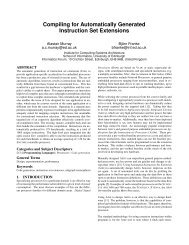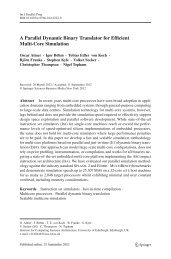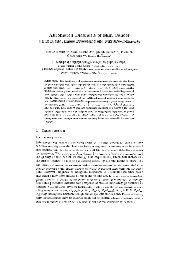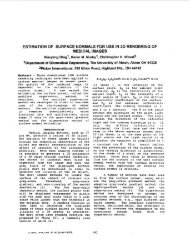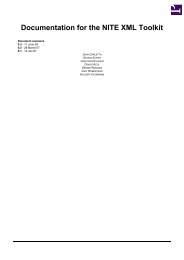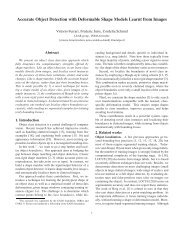WebExp2 Experimenter's Manual - School of Informatics - University ...
WebExp2 Experimenter's Manual - School of Informatics - University ...
WebExp2 Experimenter's Manual - School of Informatics - University ...
Create successful ePaper yourself
Turn your PDF publications into a flip-book with our unique Google optimized e-Paper software.
Figure 6: A resource file defining blocks <strong>of</strong> images.<br />
<br />
<br />
<br />
image1.jpg<br />
image2.gif<br />
· · ·<br />
<br />
· · ·<br />
<br />
So for example a block could be used to group an image filename with an image title – a number <strong>of</strong> file/title pair<br />
blocks can be created, then the order <strong>of</strong> the blocks can be randomised (between blocks) and each slide imports<br />
two resources from the resource set; one into an image component, and the second into a text component which<br />
describes the image displayed.<br />
5.4.3 Overriding component properties<br />
As well as defining the id attribute <strong>of</strong> each resource, you can define an arbitrary number <strong>of</strong> additional attributes.<br />
These additional attributes represent properties <strong>of</strong> the component into which the resource gets imported, and<br />
can be used to override any default properties <strong>of</strong> that component. An example <strong>of</strong> this approach is shown in<br />
figure 7.<br />
Figure 7: Resources which define additional attributes to override defaults in the timeline sequence.<br />
· · ·<br />
<br />
BLUE<br />
GREEN<br />
<br />
This illustrates one way in which a Stroop task could be constructed. If the resources in this example are<br />
imported into text components, two different results would be produced; one with the word BLUE in yellow, the<br />
other with the word GREEN in red. An experimental template only needs to describe a single text component<br />
with an import tag, and on each slide with this component, the result will be different.<br />
Any other properties <strong>of</strong> the target component may also be overridden, such as height, width, bgcolor, even<br />
type. All applicable properties you define in a resource will be coerced into the target component; any which<br />
are not appropriate will have no effect. If you do not specify content for a resource but instead leave it empty,<br />
for example , the experiment will use whatever is already defined in<br />
a tag in the experiment file. This behaviour can be used to display the same word repeatedly but<br />
in different colours. The word is defined once in the text component in the timeline, while the changing colours<br />
27



